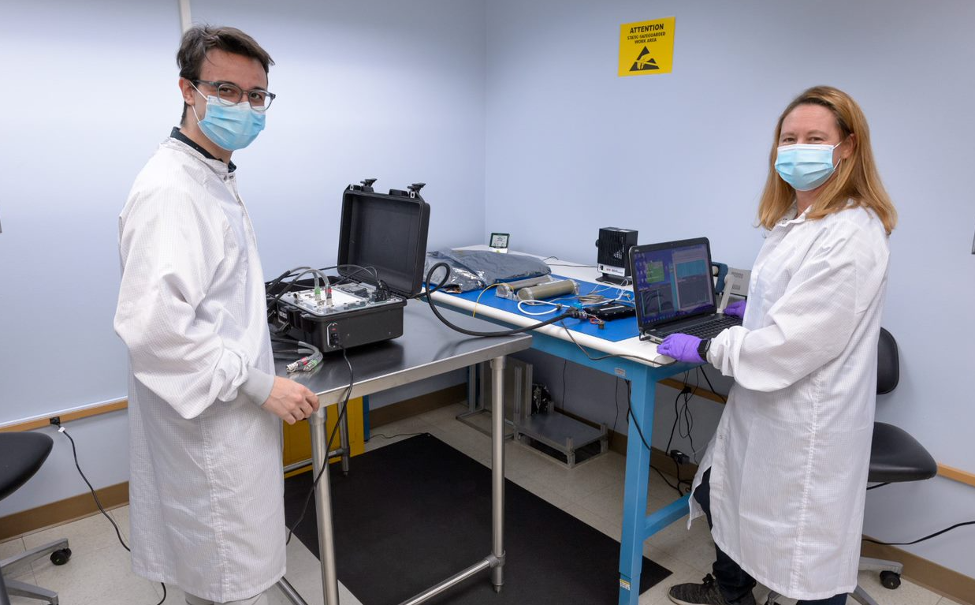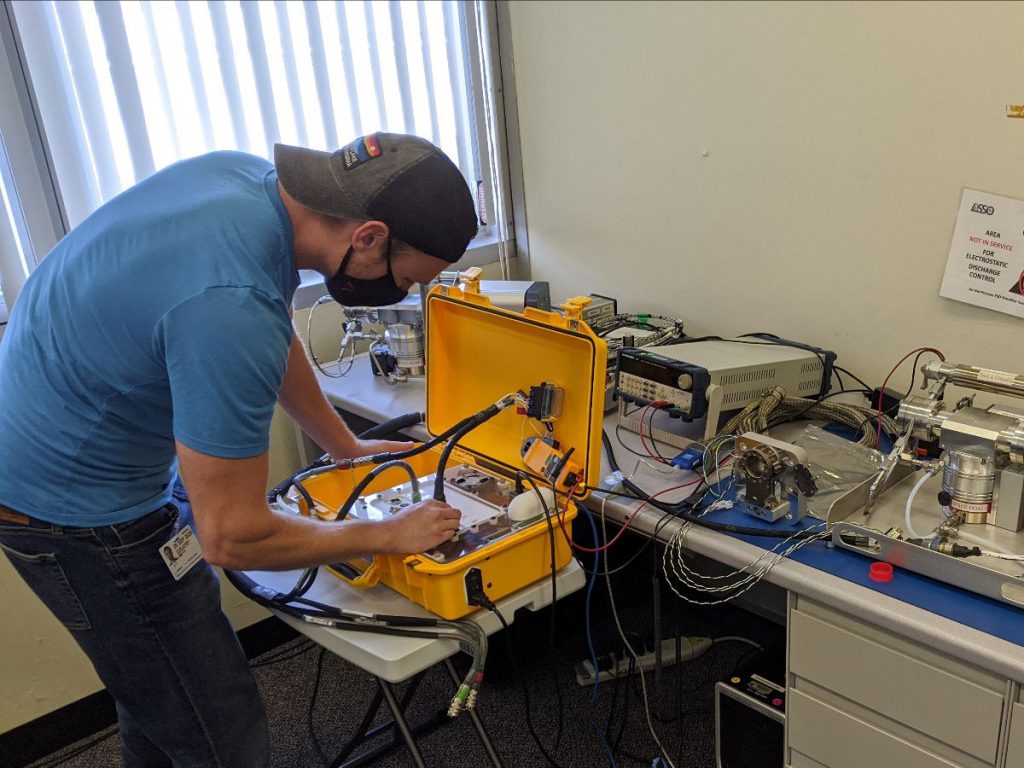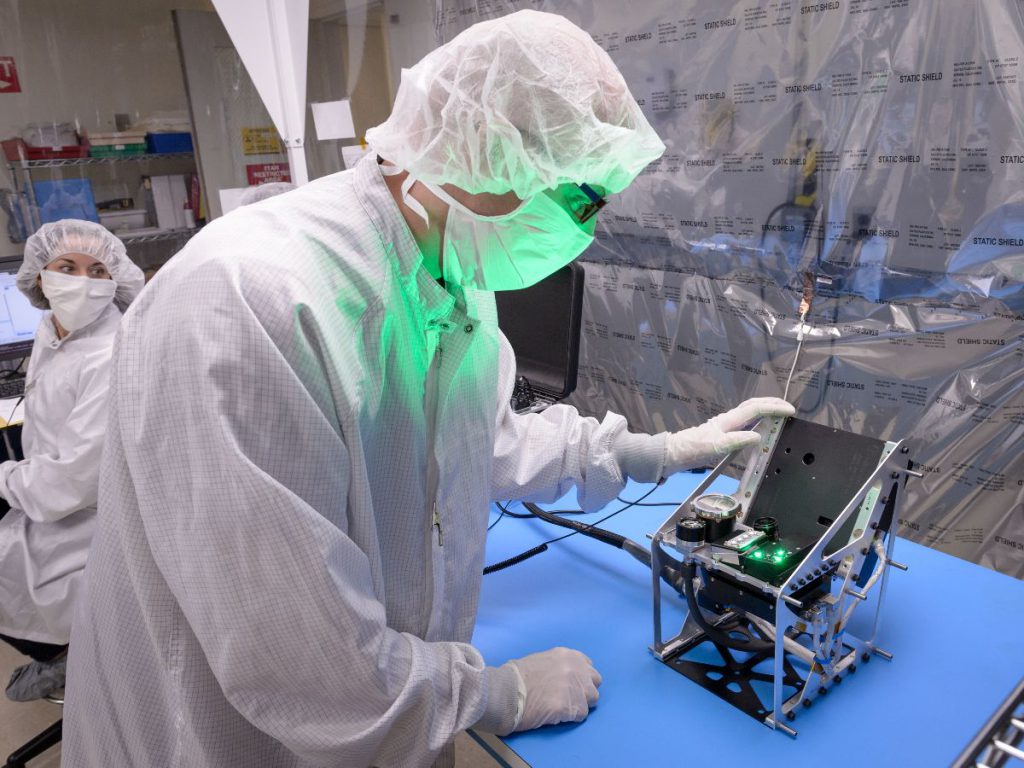Three of NASA’s payloads are set to fly aboard Astrobotic’s Peregrine lunar lander in 2021.

Pictured: John Walker Moosbrugger, Astrobotic payload manager (left), and Erin Fritzler, NASA NSS instrument manager (right)
Three of NASA’s payloads set to fly aboard Astrobotic’s Peregrine lunar lander in 2021 have successfully completed preliminary interface simulation testing between Astrobotic, NASA’s Ames Research Center, and NASA’s Kennedy Space Center payload teams.
The three payloads successfully completed simulated end to end testing of the Peregrine power, data, and software interfaces. The test included verifications of flight and ground software that will enable control of the payloads from NASA centers, via Astrobotic’s headquarters in Pittsburgh, PA.
Designed to fly on NASA’s Volatiles Investigating Polar Rover (VIPER), a mission scheduled for 2023, the three payloads – Mass Spectrometer Observing Lunar Operations (MSolo), Neutron Spectrometer System (NSS), and Near Infrared Volatile Spectrometer System (NIRVSS) – will first be integrated directly with Astrobotic’s Peregrine lander for Peregrine Mission One this year. The recent completion of interface simulation testing using Astrobotic’s Payload Interface Mobile Simulator (PIMS) verified these payloads will function correctly when integrated with Peregrine in 2021.
The first payload, the Mass Spectrometer Observing Lunar Operations (MSolo), is a commercial off-the-shelf mass spectrometer modified to work in space. NASA will use MSolo to identify molecules in the exosphere of the Moon, including possible water. It will measure the gasses coming from the lander during touchdown to identify what the lander brought to the lunar surface and will monitor for changes as the mission progresses. Astrobotic and the MSolo team successfully tested with an engineering unit that included a vacuum pump to simulate the vacuum of space.
The second is the Neutron Spectrometer System (NSS), designed to detect the amount of hydrogen below the surface of the Moon and in the general vicinity of the Peregrine lander. NSS measures the number and energy of neutrons present as radiation on the Moon, which can be used to infer the amount of hydrogen present in the environment. This detection is possible because when neutrons strike a hydrogen atom, they lose a lot of energy – a change NSS can detect. NSS can measure the total volume of hydrogen up to three feet below the surface. Compared to similar neutron detector measurements from orbit, measurements on the lunar surface can give a more detailed and accurate picture of the presence of hydrogen on the lunar surface.
The third payload, the Near Infrared Volatile Spectrometer System (NIRVSS), is comprised of three scientific instruments: the near infrared spectrometer, Ames imaging module, and longwave calibration sensor. The near infrared spectrometer captures the reflected spectra of the lunar surface when illuminated with light of a variety of wavelengths. This information can be used to determine the material properties of the lunar surface and identify if water or other materials are present in an image. The Ames imaging module is a camera that captures images to contextualize the spectrometer data. The longwave calibration system precisely measures the temperature of the lunar surface to calibrate data from the spectrometer.
Successful PIMS testing is one of the final steps before these payloads are delivered to Astrobotic for integration with the Peregrine lander. Integration will occur in early 2021 at Astrobotic’s Pittsburgh headquarters. Once integrated, the full spacecraft will complete a series of tests and then launch aboard United Launch Alliance’s Vulcan Centaur rocket. Peregrine will land on the Moon and provide power and data to the payloads, enabling their teams to operate their experiments in the lunar environment and collect invaluable data. Astrobotic is delivering NASA payloads to the Moon as part of the agency’s Commercial Lunar Payload Services project, which is rapidly acquiring lunar delivery services for payloads that advance capabilities for science, exploration, or commercial development of the Moon.
The journey for these water-hunting payloads doesn’t end here. Late in 2023, Astrobotic’s Griffin lander will touch down at the south pole of the Moon carrying these same technologies – but this time with wheels. NASA’s golf cart-sized VIPER rover will roll down the lander’s ramps onto the lunar surface and begin its mission carrying a very similar suite of payloads.




PHOTO CREDIT: NASA/Ames Research Center/Dominic Hart
Pictured: John Walker Moosbrugger, Astrobotic payload manager (left), and Erin Fritzler, NASA NSS instrument manager (right)

